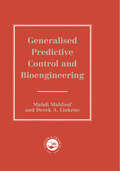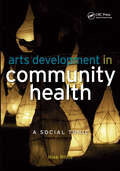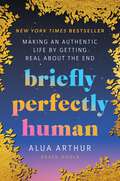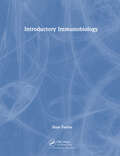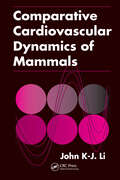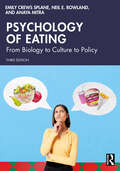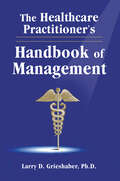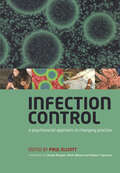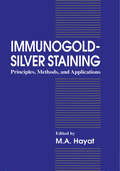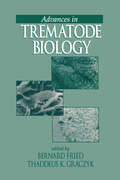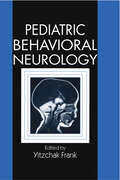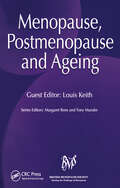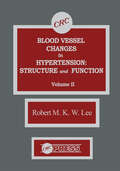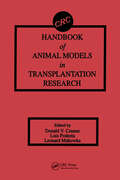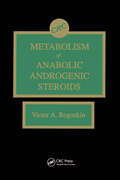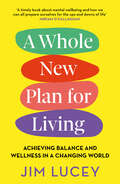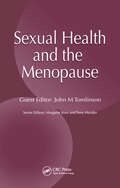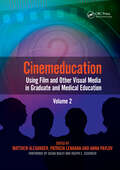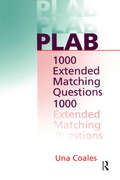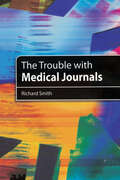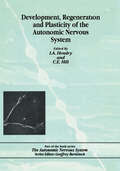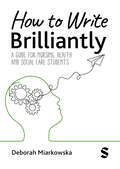- Table View
- List View
Generalized Predictive Control And Bioengineering (Series in Systems and Control)
by M Mahfouf D. A. LinkensPredictive control is a powerful tool in dealing with those processes with large time delays. Generalized Predictive Control GPC is the most popular approach to the subject, and this text discusses the application of GPC starting with the concept of long-range predictive control and its need in medicine particularly automated drug deliveries.; The concept of adaptation is also emphasized with respect to patient-to-patient parameter variations. Subsequent chapters discuss interactions, comparisons and various aspects of GPC. The book concludes by putting into perspective the generic nature of the architecture built around GPC and which provides model-based fault diagnosis with control.
Arts Development in Community Health: A Social Tonic
by Mike WhiteThis book considers how and why the field of arts development in community health has come about, the characteristics of its practice and the challenges it poses for evaluation. It summarises what has been learnt from a number of case studies and other forms of research from the UK and elsewhere.
Comparative Anatomy of the Mouse and the Rat: A Color Atlas and Text
by Gheorghe M. ConstantinescuKey features:Beautifully illustrated with detailed, full-colour images - very user-friendly for investigators, students, and technicians who work with animalsProvides essential information for research and clinical purposes, describing some structures not usually shown in any other anatomy atlasIn each set of illustrations, the same view is depicted in the mouse and the rat for easy comparisonText draws attention to the anatomical features which are important for supporting the care and use of these animals in researchEndorsed by the American Association of Laboratory Animal Science (AALAS)Comparative Anatomy of the Mouse and Rat: a Color Atlas and Text provides detailed comparative anatomical information for those who work with mice and rats in animal research. Information is provided about the anatomical features and landmarks for conducting a physical examination, collecting biological samples, making injections of therapeutic and experimental materials, using imaging modalities, and performing surgeries.
Briefly Perfectly Human: Making an Authentic Life by Getting Real About the End
by Alua ArthurNEW YORK TIMES BESTSELLERA deeply transformative memoir that reframes how we think about death and how it can help us lead better, more fulfilling and authentic lives, from America’s most visible death doula."A truly unique, inspiring perspective on the time we have, what we do with it, and how we let go of this world.... There is no one I'd trust more to guide me through an understanding of death, and how it informs life." — Jodi Picoult, New York Times bestselling author of Mad Honey and The Book of Two Ways"Briefly Perfectly Human is a beautiful, raw, light-bringing experience. Alua's voice is shimmering, singular, and pulses with humor, vulnerability, insight, and refreshing candor.... Be prepared for it to grab you, hold you tight, and raise the roof on the power of human connection." — Tembi Locke, author of From Scratch: A Memoir of Love, Sicily, and Finding HomeFor her clients and everyone who has been inspired by her humanity, Alua Arthur is a friend at the end of the world. As our country’s leading death doula, she’s spreading a transformative message: thinking about your death—whether imminent or not—will breathe wild, new potential into your life.Warm, generous, and funny AF, Alua supports and helps manage end-of-life care on many levels. The business matters, medical directives, memorial planning; but also honoring the quiet moments, when monitors are beeping and loved ones have stepped out to get some air—or maybe not shown up at all—and her clients become deeply contemplative and want to talk. Aching, unfinished business often emerges. Alua has been present for thousands of these sacred moments—when regrets, fears, secret joys, hidden affairs, and dim realities are finally said aloud. When this happens, Alua focuses her attention at the pulsing center of her clients’ anguish and creates space for them, and sometimes their loved ones, to find peace.This has had a profound effect on Alua, who was already no stranger to death’s periphery. Her family fled a murderous coup d’état in Ghana in the 1980s. She has suffered major, debilitating depressions. And her dear friend and brother-in-law died of lymphoma. Advocating for him in his final months is what led Alua to her life’s calling. She knows firsthand the power of bearing witness and telling the truth about life’s painful complexities, because they do not disappear when you look the other way. They wait for you.Briefly Perfectly Human is a life-changing, soul-gathering debut, by a writer whose empathy, tenderness, and wisdom shimmers on the page. Alua Arthur combines intimate storytelling with a passionate appeal for loving, courageous end-of-life care—what she calls “death embrace.” Hers is a powerful testament to getting in touch with something deeper in our lives, by embracing the fact of our own mortality. “Hold that truth in your mind,” Alua says, “and wondrous things will begin to grow around it.”
Introductory Immunobiology
by Huw DaviesA brief treatment of immunobiology for second year undergraduates with little previous knowledge of the topic. The author illustrates molecular, biochemical and cellular phenomena with reference to all areas of zoology, including invertebrates, to draw out common themes and principles.
Comparative Cardiovascular Dynamics of Mammals
by John K-J LiComparative Cardiovascular Dynamics of Mammals offers never-before-published data on the structure and function of the circulatory systems of the different mammalian species. This text explores classic allometry, dimensional analysis, and modern hemodynamics to establish similarity principles that provide a necessary and important step in understanding the natural common design and functional features of the cardiovascular systems of different mammals.Fluid and blood vessel mechanics, pulse transmission characteristics, cardiac energetics and mechanics, as well as heart-arterial system interaction are included in this essential reference. The sensitivity of parameters and similarity of principles in the diagnosis of cardiovascular diseases are also addressed. This book also describes the natural processes involved in the functional development of the mammalian cardiovascular system.By using modern methods to present recent findings on the similarities and differences of the mammalian cardiovascular system, the author provides an easily understood approach to this dynamic field of study.
Psychology of Eating: From Biology to Culture to Policy
by Anaya Mitra Neil E. Rowland Emily Crews SplaneThe Psychology of Eating is the essential multidisciplinary introduction to the psychology of eating, looking at the biological, genetic, developmental, and social determinants of how humans find and assimilate food.Thoroughly revised and updated, this new, third edition brings multifaceted expertise to the topic of normal and dysfunctional food intake, juxtaposing ‘normal’ eating, eating in environments of food scarcity, and the phenomenon of ‘abnormal’ eating prevalent in many modern-day developed societies. The book includes some discussion of eating disorders but takes a much broader approach to the psychology of eating. Key updates in this edition include: A new discussion of food allergies. A fully updated chapter on eating disorders, which includes discussion of binge-eating. Greater focus on junk food addition and updated information on epigenetics and the microbiome Featuring student-friendly materials such as learning objectives, talking points, glossaries, and self-assessment questions, this book is essential reading for students of psychology, eating behavior, or health sciences. It will also be useful reading for professionals in health psychology and anyone supporting those with eating disorders and obesity.
The Healthcare Practitioner's Handbook of Management
by Larry D. GrieshaberThe American system of healthcare is rapidly changing. Today, more and more of an emphasis is being placed on management skills-organizing, coordinating and managing the resources required for providing quality patient care. Medical practitioners are now expected to be efficient administrators as well as skilled clinicians. Although some may see this as a difficult hurdle, The Healthcare Practitioner's Handbook of Management shows that many healthcare providers are already well-prepared to perform management roles effectively. Through their education and clinical experience, most clinicians now have the problem-solving skills required for management - it's simply a matter of applying these skills to a different arena.In keeping with this idea, each chapter of The Healthcare Practitioner's Handbook of Management links a management topic to a clinical analogy and presents diagnostic and treatment approaches to the issue at hand. In addition, the book introduces the healthcare professional to the vocabulary and basic theories of management and shows how to transform clinical skills into managerial skills. In today's complex health care environment, these management skills are not just helpful, but essential.
Infection Control: A Psychosocial Approach to Changing Practice
by Paul Elliott Sheila Morgan Professor Mark Wilcox Dr Robert C SpencerPaul Elliott has drawn together a thought-provoking collection of topics that together explain the psychology of infection prevention and control. This is a book about how to change and improve practice, written by people who understand the trade of infection prevention and control. Reflection exercises are cleverly used throughout the text to provoke the reader to think of their own experiences in and their practice of healthcare. The reader is led into considering how improvements can be made to the delivery of infection prevention and control, and at the same time to understand why the way we think ultimately determines the likelihood of their success. Each reflection exercise is accompanied by clear and concise explanations, helping the reader to analyse and critique him/ herself and the way we do things now.
Immunogold-Silver Staining: Principles, Methods, and Applications
by M. A. HayatThis book discusses the principles, methods, and applications of immunogold-silver staining (IGSS) to biomedical areas. It focuses on the latest advances in the dynamic and progressive field of IGSS.
Advances in Trematode Biology
by Bernard Fried Thaddeus K. GraczykTrematodology - the study of a class of medically important parasitic, flat-bodied worms - has made significant advances over the past ten years. The tremendous amount of information accumulated from research discoveries and technical developments related to trematode biology makes this book a timely and necessary part of the literature. Advances in Trematode Biology presents a thorough treatment of modern trematodology, including principles and practices. With coverage of background material as well as modern methods, Advances in Trematode Biology updates researchers, practitioners, and students with new information in immunology, biochemistry, physiology, and molecular biology. Advances in Trematode Biology includes practical information on parasitological techniques, emphasizing species of medical and veterinary importance - a key reference for parasitologists, biologists, medical, and veterinary personnel. The excellent presentation of material, including well-organized tables and chapters, make Advances in Trematode Biology easy to use both as a textbook and as a reference.
Pediatric Behavioral Neurology
by Yitzchak FrankThis book assembles, for the first time, information required for the recognition, understanding, and treatment of behavioral problems resulting from neurological conditions. Its focus is two-pronged: 1) on conditions where cognitive-behavioral manifestations are major symptoms, such as attention deficit hyperactivity disorder, autism, and developmental language disorder; and 2) on conditions where these symptoms are significant but secondary, such as brain tumors, epilepsy, and AIDS. This multi-authored guide also outlines effective approaches to behavioral therapy for these conditions. Pediatric Behavioral Neurology is an excellent resource for practitioners whose work demands knowledge of the symptoms, signs, and treatment of behavioral and cognitive disorders caused by brain abnormalities. It is comprehensive, yet concise and easy to use.
Menopause, Postmenopause and Ageing
by Margaret Rees Louis Keith Tony ManderWomen live longer than men and one-third of the female population in Western societies is aged over 50. Postmenopausal health problems arising not only from ageing, but also from oestrogen deficiency, are therefore 'hot topics' for medical professionals.The third in a series published on behalf of the British Menopause Society, this book is authored by an international team of specialists who work in women's health during and postmenopause, and discusses how specific postmenopausal health problems are thought to arise and what are today's most promising treatment options.The book is split into three sections:Section 1: Determinants of diseaseCovers osteoporosis, cardiovascular disease, diabetes, dementia, breast, gynaecological and bowel cancers.Section 2: Common conditionsCovers the pathology, effects of ageing and oestrogen levels, symptoms, impact on women's lives, who and how to investigate, drug and non-drug therapies in the following conditions: dementia, myocardial infarction, stroke, osteoporosis, arthritis, incontinence.Section 3: Care of an ageing populationCaring at home, providing residential care.Menopause, postemenopause and Ageing provides a concise, easy-to-read guide for the multidisciplinary team involved in the management of health problems after the menopause. This book will be a valued resource for gynaecologists, general physicians, geriatricians, oncologists, cardiologists and orthopaedic surgeons, general practitioners, nurse specialists, medical students and all of those involved in providing healthcare to the menopausal woman.
Blood Vessel Changes in Hypertension Structure and Function, Volume II
by R.M.K.W. LeeWritten by established researchers, this two-volume publication provides timely, comprehensive and insightful reviews on recent discoveries in the etiology of hypertension. Structural changes of the blood vessels in hypertension in relation to connective tissue, cerebral vessel structure and innervation, smooth muscle cell hypertrophy and/or hyperplasia, and rarefaction of microvessels are discussed. Also presented are the effects of antihypertensive therapy on vessel structure and function. A unique feature is the inclusion of a chapter on pulmonary vascular changes in pulmonary hypertension, which shows certain changes that are similar to systemic hypertension. This book is of major interest to researchers involved in the study of hypertension and the biology of the blood vessels.
Handbook of Animal Models in Transplantation Research
by Donald V. Cramer Luis G. Podesta Leonard MakowkaHandbook of Animal Models in Transplantation Research is a new surgical handbook that provides detailed information concerning the transplantation of a variety of tissues in experimental animals. The text provides a practical guide for experienced investigators to develop new surgical transplantation models for application in a laboratory setting. Each chapter gives consistent descriptions of the anatomical considerations, the surgical model, and potential applications of the procedure. The organ systems covered include the heart and/or lung, liver, small bowel, kidneys, and bone marrow. The species selected for representation of each experimental model is based upon the usefulness and frequency of the model for studies in transplantation research. This book is important for all experimental surgeons, transplantation biologists, and students of surgical research.
Metabolism of Anabolic-Androgenic Steroids
by Victor A. RogozkinThis book presents an authoritative review of the research regarding the influences of anabolic-androgenic steroids on metabolism. The book provides a concise description of the biochemistry of these steroids using simple terms and includes methods of separation and their clinical applications. The first section of the book examines the general structure, nomenclature, and classification of anabolic-androgenic steroids. Subsequent chapters explore concepts basic to understanding the pathways of their metabolism in both target and non-target tissues, including the interactions of steroids with receptors and the effects of steroids on the cellular metabolism of skeletal muscle. The changes and molecular base of modifications in metabolism during exercise involving anabolic-androgenic steroids are also described. Finally, a comprehensive review of methods for scanning and identifying anabolic-androgenic steroids in biological fluids is presented, as well as a discussion regarding the applicability and limitations of these techniques. The book provides valuable reference information for all scientists and clinicians engaged in sports medicine, exercise biochemistry, and endocrinology.
A Whole New Plan for Living: Achieving Balance and Wellness in a Changing World
by Jim LuceyThe comprehensive and powerful new book from renowned psychiatrist Jim Lucey.We will all experience times in our lives when our health is challenged. As we navigate an uncertain world, stressors such as financial worries, illness, loss, isolation and loneliness can turn into distress, anxiety and depression. In A Whole New Plan for Living, leading psychiatrist Prof Jim Lucey presents ten powerful steps to show us how, by maintaining balance and wellness in our daily lives we can achieve overall health and wellbeing, ready for the challenges life presents to us. From understanding wellness, to managing stress and distress, to the opportunity for mental health recovery no matter the circumstances, A Whole New Plan for Living shows us how by making small changes, we can achieve optimum mental health, become more resilient and live with hope for the future.
Practical Psychiatry of Old Age, Fifth Edition
by John Wattis Stephen CurranMulti-disciplinary in its approach, this book details key psychiatric conditions, their assessment and management in line with modern developments, including the latest developments in healthcare policy. It has been thoroughly revised to incorporate the National Institute for Health and Clinical Excellence (NICE) Guidance.Case studies are used throughout to aid comprehension and illustrate the realities of working in this area.Now in its Fifth Edition, Practical Psychiatry of Old Age is ideal as a clinical primer for those in training, or as a day-to-day reference for healthcare professionals working with older people.
Sexual Health and The Menopause
by Margaret Rees Tony Mander John M TomlinsonPublished on behalf of the British Menopause Society, this is a practical and sensitive collection of articles on common sexual health issues which concern menopausal women and their partners. Many older women have an increased sexual response owing to a reduced fear of pregnancy, the end of menstrual distress and no longer needing contraception; however, with increased age comes associated sexual problems for both men and women.Edited and written by leading specialists, each chapter is a minimum of 1500 words plus 10-15 up-to-date references for further reading. This book is recommended to GPs, nurses, and all professionals working in family planning and genitourinary medicine.
Cinemeducation: Using Film and Other Visual Media in Graduate and Medical Education
by Anna Pavlov Patricia Lenahan Alexander MatthewCompanion volume to Cinemeducation Volume 1 Cinemeducation, Volume 2 outlines a comprehensive approach to using film in graduate and medical education. It provides readers with a wide array of film excerpts ready for immediate application in the classroom. Each excerpt includes the counter time, year of release, names of actors, a short description of the movie and the scene being highlighted as well as discussion questions. Entire chapters are dedicated to reality television, mainstream television, music videos, documentaries and YouTube. Clearly structured, this second volume dives deep into human experiences. Authors from five continents have composed 49 chapters devoted to a wide assortment of new topics relevant to medical and postgraduate healthcare education. Some of the specific issues covered include substance abuse, gambling, dealing with tragedy, diabetes, heart disease, chronic illness and obstetrics as well as mental health problems. Some films portray health care professionals both positively and negatively and these are presented with rich detail. A wide variety of specialties and different health careers are covered. All of these areas converge on the common ground of compassion in the medical experience. This book is ideal for the undergraduate or postgraduate classroom. All healthcare educators will appreciate its comprehensive scope and innovative approach, including those in psychology, social services, dentistry and veterinary science.
PLAB: 1000 Extended Matching Questions
by Una F CoalesThis book is an essential purchase for all candidates sitting Part 1 of the PLAB exam administered by the UK General Medical Council. All doctors from non-EC countries who wish to practice in UK must sit the PLAB exam which comprises 200 Extended Matching Questions (EMQs). This book contains 1000 practice EMQs of a similar type to those in the exam.The questions cover all aspects of the new syllabus, which not only includes a range of clinical topics but also requires knowledge of the GMC's Duties of a Doctor, principles and practice of evidence-based medicine, and clinical governance. Recommended to all candidates sitting the new PLAB test.
The Trouble with Medical Journals
by Richard SmithIt is a turbulent time for STM publishing. With moves towards open access to scientific literature, the future of medical journals is uncertain and unpredictable. This is the only book of its kind to address this problematic issue.Richard Smith, a previous editor of the British Medical Journal for twenty five years and one of the most influential people within medical journals and medicine depicts a compelling picture of medical publishing. Drawn from the author's own extensive and unrivalled experience in medical publishing, Smith provides a refreshingly honest analysis of current and future trends in journal publishing including peer review, ethics in medical publishing, the influence of the pharmaceutical industry as well as that of the mass media, and the risk that money can cloud objectivity in publishing.Full of personal anecdotes and amusing tales, this is a book for everyone, from researcher to patient, author to publisher and editor to reader. The controversial and highly topical nature of this book, will make uncomfortable reading for publishers, researchers, funding bodies and pharmaceutical companies alike making this useful resource for anyone with an interest in medicine or medical journals.Topic covered include: Libel and medical journals; Patients and medical journals; Medical journals and the mass media; Medical journals and pharmaceutical companies: uneasy bedfellows; Editorial independence; misconduct; and accountability; Ethical support and accountability for journals; Peer review: a flawed process and Conflicts of interest: how money clouds objectivity.This is a unique offering by the former BMJ editor- challenging, comprehensive and controversial. This must be the most controversial medical book of the 21st Century John Illman, MJA NewsLively, full of anecdote and he [Smith] is brutally honest British Journal of Hospital Medicine*************************************************************************************************Please note that the reference to Arup Banerjee on page 100 of this book should be to Anjan Banerjee. We apologise to Professor Arup Banerjee for this oversight.*************************************************************************************************
Development, Regeneration and Plasticity of the Autonomic Nervous System
by I. A. Hendry C. E. HillEach volume in the Autonomic Nervous System series deals with a different area of autonomic control in health and disease. This, the second volume, provides an overview on the nature of the factors that exert constraints on the differentiation and maturation of the autonomic nervous system. Subjects covered include: development of autonomic neurones; molecules affecting nerve growth and survival; regeneration after injury; and the degree to which the wiring of the nervous system is rigid or fixed.
How to Write Brilliantly: A Guide for Nursing, Health & Social Care Students
by Deborah MiarkowskaAs a nursing or health and social care student, academic writing is one of the main ways you’re assessed. However, how to approach your assignments can be a challenge. This is a short, simple guide to the academic writing process, helping you to grow in confidence, to write critically and engagingly, and to develop your voice. Whether you are just starting your course, returning to study or looking to improve your style, you’ll find out how to: · Get into the mindset for independent study and reflection · Source and evaluate literature and evidence · Develop your critical writing skills · Structure your work
How to Write Brilliantly: A Guide for Nursing, Health & Social Care Students
by Deborah MiarkowskaAs a nursing or health and social care student, academic writing is one of the main ways you’re assessed. However, how to approach your assignments can be a challenge. This is a short, simple guide to the academic writing process, helping you to grow in confidence, to write critically and engagingly, and to develop your voice. Whether you are just starting your course, returning to study or looking to improve your style, you’ll find out how to: · Get into the mindset for independent study and reflection · Source and evaluate literature and evidence · Develop your critical writing skills · Structure your work
